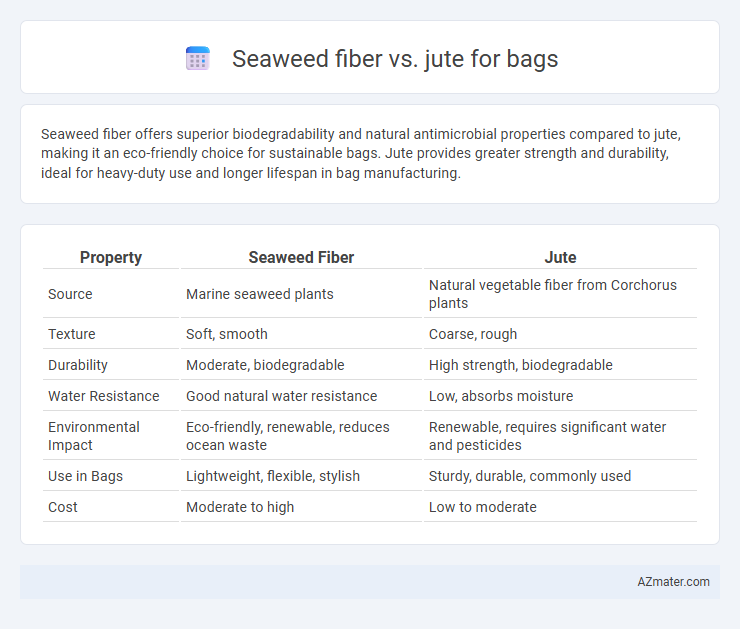Seaweed fiber offers superior biodegradability and natural antimicrobial properties compared to jute, making it an eco-friendly choice for sustainable bags. Jute provides greater strength and durability, ideal for heavy-duty use and longer lifespan in bag manufacturing.
Table of Comparison
| Property | Seaweed Fiber | Jute |
|---|---|---|
| Source | Marine seaweed plants | Natural vegetable fiber from Corchorus plants |
| Texture | Soft, smooth | Coarse, rough |
| Durability | Moderate, biodegradable | High strength, biodegradable |
| Water Resistance | Good natural water resistance | Low, absorbs moisture |
| Environmental Impact | Eco-friendly, renewable, reduces ocean waste | Renewable, requires significant water and pesticides |
| Use in Bags | Lightweight, flexible, stylish | Sturdy, durable, commonly used |
| Cost | Moderate to high | Low to moderate |
Introduction: Comparing Seaweed Fiber and Jute for Bags
Seaweed fiber and jute are emerging as sustainable materials for eco-friendly bags, each offering unique environmental benefits and functional properties. Seaweed fiber is prized for its biodegradability, antibacterial qualities, and lightweight texture, making it ideal for modern, durable bags with reduced ecological impact. Jute, a traditional natural fiber, is known for its strength, breathability, and cost-effectiveness, commonly used in sturdy tote bags and packaging with a long history of agricultural sustainability.
Material Origins: Seaweed Fiber vs Jute
Seaweed fiber, derived from sustainable marine algae, offers a renewable and biodegradable alternative to traditional plant-based fibers. Jute, obtained from the Corchorus plant native to South Asia, has long been valued for its strength and durability in bag manufacturing. While both fibers support eco-friendly production, seaweed fiber's unique marine origin contributes to antibacterial properties and enhanced softness compared to the coarser texture of jute.
Environmental Impact and Sustainability
Seaweed fiber offers a highly sustainable alternative to jute, as it is cultivated without freshwater or pesticides, reducing environmental strain and promoting ocean ecosystem health. Jute, while renewable and biodegradable, requires considerable water and chemical inputs during cultivation, leading to soil degradation and water pollution. The biodegradability and low carbon footprint of seaweed fiber bags make them an innovative choice for eco-friendly products compared to traditional jute bags.
Physical Properties and Durability
Seaweed fiber exhibits higher tensile strength and flexibility compared to jute, making it more resistant to wear and tear in bag manufacturing. Its natural moisture-wicking properties enhance durability by preventing mold and mildew growth, whereas jute tends to absorb moisture, leading to quicker degradation. Both fibers offer eco-friendly alternatives, but seaweed fiber's superior physical properties provide longer-lasting and more resilient bags.
Production Processes: Seaweed Fiber and Jute
Seaweed fiber is extracted through a sustainable process involving the washing, drying, and grinding of seaweed, followed by a chemical or enzymatic treatment to separate fibers, which are then spun into yarn suitable for bag manufacturing. In contrast, jute production starts with retting jute stalks in water pools to soften the fibers, followed by stripping, washing, drying, and spinning into coarse threads used in bag fabrication. The eco-friendly and renewable nature of seaweed fiber production offers a lower environmental impact compared to traditional jute processing, which requires extensive water usage and labor-intensive retting methods.
Aesthetic Appeal and Design Flexibility
Seaweed fiber offers a smooth texture and natural sheen, enhancing the aesthetic appeal of bags with a subtle, organic look that is well-suited for modern, eco-friendly designs. In contrast, jute has a coarse, rustic texture that provides a vintage, earthy charm, often favored for traditional or bohemian styles. Design flexibility is higher in seaweed fiber due to its finer weave and ability to hold vibrant colors, while jute's durability supports bold, structural shapes but limits intricate detailing.
Biodegradability and End-of-Life Disposal
Seaweed fiber and jute both offer excellent biodegradability, breaking down naturally without releasing harmful toxins, making them eco-friendly options for bag production. Seaweed fiber decomposes rapidly in marine environments, reducing ocean pollution risks, while jute degrades effectively in soil, supporting sustainable composting practices. End-of-life disposal for seaweed fiber bags is advantageous in coastal areas due to its marine biodegradation, whereas jute bags are widely compostable and recyclable, enhancing circular economy benefits.
Cost Analysis: Seaweed Fiber Bags vs Jute Bags
Seaweed fiber bags typically incur higher production costs due to the specialized extraction and processing of algae-based materials, whereas jute bags benefit from more established supply chains and lower raw material expenses. The price per unit for seaweed fiber bags can be 20-30% higher compared to jute bags, influencing overall market competitiveness. However, seaweed fiber bags offer enhanced biodegradability and eco-friendly branding, which may justify the additional investment despite the cost disparity.
Consumer Preferences and Market Trends
Seaweed fiber bags are gaining traction among eco-conscious consumers due to their sustainable sourcing and biodegradability, aligning with trends favoring green materials over conventional options. Jute bags maintain strong appeal for their durability, affordability, and rustic aesthetic, especially in emerging markets where cost-effectiveness drives purchase decisions. Market analysis reveals growing demand for seaweed fiber products in premium segments, while jute sustains dominance in bulk and everyday use, indicating diversified consumer preferences based on environmental impact and price sensitivity.
Future Outlook: The Role of Seaweed Fiber and Jute in Eco-Friendly Bags
Seaweed fiber and jute are emerging as pivotal materials in the production of eco-friendly bags due to their renewable, biodegradable properties and low environmental impact. The global shift towards sustainable fashion and increased consumer demand for plastic alternatives are driving innovation and market growth for seaweed fiber and jute products. Seaweed fiber, with its rapid regeneration rate and natural anti-bacterial qualities, complements jute's strength and durability, positioning both fibers as key players in the future of sustainable bag manufacturing.

Infographic: Seaweed fiber vs Jute for Bag
 azmater.com
azmater.com